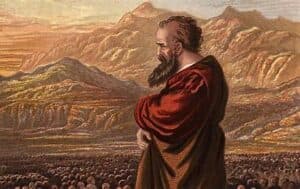God's people are sealed during the Time of the End.
SUMMARY OF THIS ARTICLE
THE FIFTH SEAL IS THE POINT IN TIME WHEN THE ANGEL BRINGS THE SEAL OF GOD OUT OF HEAVEN.
 The first four seals (Rev 6:1-8) describe the timeless realities of the church age. But the fifth seal (Rev 6:9-11) seems to be a specific point in history when the souls under the altar receive white robes and are told to rest for a little while longer (Rev 6:9-11).
The first four seals (Rev 6:1-8) describe the timeless realities of the church age. But the fifth seal (Rev 6:9-11) seems to be a specific point in history when the souls under the altar receive white robes and are told to rest for a little while longer (Rev 6:9-11).
The article on the fifth seal considered this question and proposes that the fifth seal symbolizes a general principle, namely that the persecution of God’s people call out to God to set things right.
 However, Revelation 7:1-4, where an angel brings the seal of the living God out of heaven and 144000 are sealed, is parallel to the fifth seal. For example, both:
However, Revelation 7:1-4, where an angel brings the seal of the living God out of heaven and 144000 are sealed, is parallel to the fifth seal. For example, both:
-
- Refer to the past, present, and to future;
- Involve a delay until God’s people are mature;
- Give a token of salvation to God’s people; and
- Are followed by massive destruction.
As discussed above, the seal of God is only available in the end-time. This means that the angel brings the seal down from heaven at a specific point in time. Then the parallels between the sealing and the fifth seal imply that the fifth seal is more than a general principle and also a point in history; the same point in time when the angel brings the seal out of heaven (Rev 7:1-3).
THE SEAL OF GOD COMES FROM HEAVEN IN THE TIME OF THE END.
 Then the question is, what is this point in time? Since the book of Daniel is the foundation on which Revelation rests, we should find this point in history in Daniel. Since, in the fifth seal, God’s people are killed both before and after this point in time, we need to find a similar point in time in Daniel. There is such a point in time in Daniel 12, namely “the time of the end” (Dan 12:4), when the prophecies of Daniel will be understood:
Then the question is, what is this point in time? Since the book of Daniel is the foundation on which Revelation rests, we should find this point in history in Daniel. Since, in the fifth seal, God’s people are killed both before and after this point in time, we need to find a similar point in time in Daniel. There is such a point in time in Daniel 12, namely “the time of the end” (Dan 12:4), when the prophecies of Daniel will be understood:
-
- Before that time, God’s people will be persecuted for “a time, times, and half a time” and
- During “the time of the end,” they will “finish shattering the power of the holy people” (Dan 12:7).
For these reasons, it is proposed that the point in history, when the souls under the altar are told to rest a little while longer, and when the angel brings the seal of God out of heaven, is the beginning of “the time of the end.”
THE LITTLE BOOK OF REVELATION 10 ALSO COMES FROM HEAVEN IN THE TIME OF THE END.
 This conclusion finds support in Revelation 10. In that chapter, an angel brings something else out of heaven at a specific point in time, namely “a little book which was open” (Rev 10:1-2). He gives it to John to eat and tells John to “prophesy again” (Rev 10:9-11). In doing this, John symbolizes the church receiving a special message from heaven.
This conclusion finds support in Revelation 10. In that chapter, an angel brings something else out of heaven at a specific point in time, namely “a little book which was open” (Rev 10:1-2). He gives it to John to eat and tells John to “prophesy again” (Rev 10:9-11). In doing this, John symbolizes the church receiving a special message from heaven.
What makes the prophecy of Revelation 10 particularly relevant to the discussion above is that the little open book is understanding of the book of Daniel (see discussion below). This means that the little book comes down from heaven at the beginning of the time of the end (Dan 12:4). Therefore, both the seal of God and the little book come out of heaven in “the time of the end.”
– END OF SUMMARY –
IS THE FIFTH SEAL
A POINT IN TIME?
The first horseman (the first seal) has been interpreted as the gospel going out. This does not happen at one specific point in time; it happens throughout the church age. The same applies to the bloodshed, famine, and pestilence of the next three horsemen. The first four seals, therefore, describe timeless characteristics of the church age.
But the fifth seal (Rev 6:9-11) seems to be a specific point in history. It describes God’s slain souls underneath the altar crying out:
“How long, O Lord, holy and true,
will You refrain from judging and avenging
our blood on those who dwell on the earth?“
But they are told to wait. Each of them is given a white robe and they are told that to:
“Rest for a little while longer,
until the number of their fellow servants …
who were to be killed …
would be completed also.“
IT IS NOT A POINT IN TIME.
The article on the fifth seal considered this question and found indications that the fifth seal is not a specific point in history:
-
- John sees the souls under the altar; symbolizing that God’s people are sacrificed on the altar for their witness. People have been dying for their witness ever since Abel.
– - They cry out for revenge; symbolizing God’s awareness of the injustice to His people and His desire to set things right. God has always been aware of this.
– - These “souls” receive white robes; indicating acceptance into God’s kingdom. In Revelation, people keep and make their robes white while alive on earth (Rev 3:4-5, 18; 7:14; 19:7-8). They do not receive white robes at any specific point in history.
– - And they are told to wait “a little while longer.” In Revelation, time is always short (Rev 1:1, 3 and 12:12), so this does not prove that this is a specific event soon before the return of Christ.
- John sees the souls under the altar; symbolizing that God’s people are sacrificed on the altar for their witness. People have been dying for their witness ever since Abel.
IT IS A GENERAL PRINCIPLE.
The article on the fifth seal, therefore, proposes that the fifth seal is not a specific point in history but a general principle, namely that the main point of the seals is that the gospel will go out (first seal) but it will be rejected and God’s people will be persecuted. This is consistent with the conclusion that the sealed book is the book of life and that the purpose of breaking the seals is to refute Satan’s objections to the people whom God has chosen for eternal life. By breaking the seals, Christ directs events on earth to show that God’s decisions are perfect and that the people whom God has chosen for eternal life are worthy. Similarly, Christ admonished the seven letters:
“To him who overcomes,
I will grant to eat of the tree of life
which is in the Paradise of God” (Rev 2:7).
Revelation knows nothing of the doctrine that is so prevalent in Protestantism, namely that God randomly chooses people, irrespective of how they live. For a discussion, see, Man is judged by his deeds; not justified by the works of the law.
THE SEALING IS PARALLEL TO THE FIFTH SEAL.
Revelation 7:1-4 describes the sealing of God’s people. While four angels hold back the four winds of the earth, another angel ascends from the east (the rising of the sun) with the seal of the living God and cry out to the four angels:
“Do not harm the earth or the sea or the trees
until we have sealed the bond-servants of our God
on their foreheads” (Rev 7:3).
Then follows the sealing of the 144000 (Rev 7:4). For the following reasons, it is proposed that the sealing is parallel to the fifth seal:
1. Both precede the sixth seal.
The fifth seal precedes the sixth. The sealing also must precede the sixth seal because the sixth seal has the signs of Christ’s return while the sealing of God’s people must precede His return.
2. Both refer to the past, present, and to future.
FIFTH SEAL
THE SEALING
PAST
Some of God’s people have been martyred.
Four angels have been restraining the winds
PRESENT
White robes are given to the souls under the altar after.
An angel brings the seal of God from the east.
FUTURE
Their brethren must be completed.
The angels will continue to restrain the winds until all of God’s servants are sealed.
3. Both involve a delay
until something happens to God’s people.
-
-
- Fifth seal – The souls must “rest a little while longer” until their “fellow servants” have been completed.
- Sealing – The release of the winds is delayed until the servants of God are sealed (Rev 7:1-3).
-
4. Both complete the saints qualitatively.
-
-
- Fifth seal – The Greek text does not contain the word “number.” It contains the verb plêrôthôsin which means “filled, completed, made full.” The NASB adds “the number” (Rev 6:11), but put it in italics. The article on the Fifth Seal explains this as qualitative completion.
– - Sealing – 144000 are sealed (Rev 7:4-8). The article on the 144000 explains that this number must be understood qualitatively; not quantitatively.
- Fifth seal – The Greek text does not contain the word “number.” It contains the verb plêrôthôsin which means “filled, completed, made full.” The NASB adds “the number” (Rev 6:11), but put it in italics. The article on the Fifth Seal explains this as qualitative completion.
-
5. In both, a token of salvation is given to the saints.
-
-
- Fifth seal – White robes (Rev 6:11)
- Sealing – The seal of the living God (Rev 7:1-3)
-
6. Both are followed by massive destruction.
-
-
- The fifth seal is followed by the 6th seal in which a great earthquake displaces all mountains and islands.
- The sealing is followed by the winds that “harm” the earth and sea.
-
7. Both are followed by the plagues of Revelation 16.
-
-
- Fifth seal: Still another article concluded that the Sixth Seal includes or follows after the seven last plagues. This means that the fifth seal is followed by the seven last plagues.
– - Sealing: A previous article concluded that the “winds” of Rev 7:1 are another symbol for the seven last plagues. Since the sealing precedes the release of the winds, the sealing precedes the seven last plague,
- Fifth seal: Still another article concluded that the Sixth Seal includes or follows after the seven last plagues. This means that the fifth seal is followed by the seven last plagues.
-
THE FIFTH SEAL BEGINS THE SEALING.
It was argued previously that the seal of God is only available in the end-time. That means that the angel brings the seal of God down from heaven at a specific point in time during the church age. The parallels between the sealing and the fifth seal steer us into the direction that the fifth seal is not merely a general principle but that it:
-
- Also refers to a point in history and that it
- Refers to the same point in history as in the sealing, namely when the angel brings the seal of the living God out of heaven (Rev 7:1-3).
These parallels also imply that:
-
- The seal of God is related to the white robe of the fifth seal. However, it is not the same. Both signify acceptance into God’s eternal kingdom. But they are different because God’s resting (dead) saints (Rev 6:11; Dan 12:13) receive the white robe while the living saints receive the seal of God.
– - The ‘completion of their “fellow servants” in the fifth seal is the same as the sealing of “the bond-servants of our God” (Rev 7:3).
- The seal of God is related to the white robe of the fifth seal. However, it is not the same. Both signify acceptance into God’s eternal kingdom. But they are different because God’s resting (dead) saints (Rev 6:11; Dan 12:13) receive the white robe while the living saints receive the seal of God.
WHAT POINT IN TIME IS IN VIEW?
If we then conclude that the fifth seal also describes a specific point in history, namely when an angel brings the seal of God from heaven, then the question is, what is this point in time?
It must be much later than Christ’s ascension because there are four seals between Christ’s ascension and enthronement (as described in Revelation 5) and the fifth seal. But it is before the return of Christ, for the next (sixth) seal has the signs associated with the return of Christ (Rev 6:12-17; cf. Matt 24:29). The fifth seal, therefore, is a point in history close to the end of the church age. For it to be specifically identified like this, something specific and important happens at that point in time.
THE POINT IN TIME IN DANIEL
The book of Daniel is the foundation on which Revelation is built. (For a discussion of the links between Daniel and Revelation, see the Seventh Seal. E.g. Rev 10:6; 13:2) For that reason, and because the point in time in the fifth seal must be important, we should be able to find it mentioned by Daniel’s prophecies.
Since the theme of the fifth seal is the persecution of God’s people, with the killing of God’s people both before and after this point in time (Rev 6:9-11), we need to find a point in time in Daniel’s prophecies that also has the persecution of God’s people both before and after that point in time. There is such a point in time in Daniel 12:
TIME OF THE END
– A TIME PERIOD
Daniel 12:4 reads:
“But as for you, Daniel,
conceal these words and seal up the book
until the end of time;
many will go back and forth,
and knowledge will increase” (Dan 12:4).
The phrase “end of time” sounds like one specific day right at the end of history. But Young’s Literal Translation renders it as “the time of the end,” which may be understood as a time period. For the following reasons, that is perhaps a better translation:
-
- Daniel uses a different phrase for the very end of time, namely “the end of the days” (Dan 12:13 YLT) or “the end of the age” (Dan 12:13 NASB). At “the end of the days,” Daniel himself will “rise again for your allotted portion” (Dan 12:13). This is when “your people … will be rescued” (Dan 12:1) and “many of those who sleep in the dust of the ground will awake” (Dan 12:2).
– - Furthermore, verse 4 indicates that “the time of the end” is not a point in time but a period during which “knowledge will increase,” namely knowledge of Daniel’s prophecies. This means that “the time of the end,” is not a single moment but a time period.
- Daniel uses a different phrase for the very end of time, namely “the end of the days” (Dan 12:13 YLT) or “the end of the age” (Dan 12:13 NASB). At “the end of the days,” Daniel himself will “rise again for your allotted portion” (Dan 12:13). This is when “your people … will be rescued” (Dan 12:1) and “many of those who sleep in the dust of the ground will awake” (Dan 12:2).
TWO PERSECUTIONS
Then, in Daniel 12:5, an angel asks:
“How long will it be until the end of these wonders?”
“These wonders” refer to the resurrection of the dead and the events preceding it, as mentioned in the first verses of Daniel 12. This question received a double answer:
-
- “It would be for a time, times, and half a time;
- and as soon as they finish shattering the power of the holy people, all these events will be completed” (Daniel 12:7).
The “time, times, and half a time” is first mentioned in Daniel 7:25, where it is the period during which the evil horn will persecute “the saints of the Highest One.” This evil horn grows out of the Roman Empire and has been identified as the Church of the Middle Ages. Consequently, the “time, times, and half a time” refer to the Middle Ages. Daniel 7:25 identifies it specifically as a period of persecution for God’s people.
While Daniel 7 and 8, where we find the “time, times, and half a time” for the first time, focus on history in general, the focus in Daniel 12 is on the end-time, as indicated by the references in the opening verses to the resurrection of the dead (Dan 12:2-3) and the promise in verse 4 that Daniel’s prophecies would be understood in “the time of the end” (Dan 12:4, 9). For this reason, it is proposed that the “finish shattering the power of the holy people” (Dan 12:7) is NOT part of the “time, times, and half a time” but a separate and later period of persecution DURING “the time of the end.”
Given the context in Daniel 12, the “finish shattering the power of the holy people” is the final end-time persecution that will follow after Daniel’s prophecies have been understood and preached.
POINT IN TIME IN DANIEL 12
Daniel 12, therefore, also refers to a specific point in history with persecution on both sides of it. That point in time is the beginning of “the time of the end” when the prophecies of Daniel will be understood:
Before that point in time, God’s people were persecuted for “a time, times, and half a time.
After that point in time, during “the time of the end,” the prophecies of Daniel would be become understood and preached, followed by the “finish shattering the power of the holy people.”
THE BEGINNING OF THE TIME OF THE END
Since both the fifth seal and Daniel 12 refer to a specific point in time in history, with persecution both before and after this point in time, and since Revelation is built on the foundation of Daniel’s prophecies, it is proposed that the point in history in the fifth seal, when the souls under the altar are told to rest a little while longer, and when the angel brings the seal of God out of heaven, is the beginning of “the time of the end.”
THE LITTLE BOOK OF REVELATION 10 ALSO COMES FROM HEAVEN IN THE TIME OF THE END.
We encounter another point in history in Revelation 10. An angel comes down from heaven. “He had in his hand a little book which was open” (Rev 10:1-2). He gives it to John to eat and tells John to “prophesy again concerning many peoples” (Rev 10:9-11). In this prophecy, John is not only an observer but symbolizes the church. It means that the church will receive a special message from heaven with instructions to “prophesy again,” which means that the church already prophesied before it received the new message from heaven. The new message coming down from heaven, therefore, is another point in history time, with prophesying both before and after this moment.
What makes the prophecy of Revelation 10 particularly relevant to the discussion above is that the little open book is understanding of the book of Daniel. This is made clear by the many parallels between Revelation 10 and Daniel 12. Compare, particularly, the oaths in Daniel 12:7 and Rev 10:5-7. This means that John’s eating of the little book symbolizes understanding of Daniel’s prophecies and the “prophesy again” is the preaching thereof.
Since the little book from heaven is understanding of the book of Daniel, and since Daniel 12 promised that the book of Daniel will be understood in the time of the end, the little book comes down from heaven at the beginning of the time of the end.
In conclusion:
The ‘present time’ in both the seals and in the trumpets is the point in time in Daniel 12 when Daniel’s prophecies will be understood.
Both the seal of the living God and the little open book come down out of heaven at the beginning of “the time of the end.”
There is another connection between the sealing (Rev 7:1-3) and the little open book (Rev 10:1-11); both are the first part of the interlude between the sixth and the seventh elements of their respective series. Both interludes, therefore, start at the beginning of the time of the end and describe events up to “the end of the age” (Dan 12:13; cf. Rev 8:1 and 11:15), with the seventh elements being “the end of the age” itself.
FINAL CONCLUSIONS
The fifth seal symbolizes a general principle, but also a point in history; the same point in time when the angel brings the seal out of heaven (Rev 7:1-3).
This is the beginning of “the time of the end.”
This is also when the “a little book which was open” (Rev 10:1-2) comes out of heaven.
ARTICLES ON THE SEVEN SEALS
OVERVIEW
-
- Verse-by-verse summary – Revelation 4:1-8:1
- List of articles with brief descriptions
- People’s deeds will refute Satan’s criticism of God’s judgments. (This article pulls together several main concepts in other articles.)
REVELATION 4
-
- Revelation 4:1-8 – Verse by verse
- The 24 elders (4:4) are humans in God’s immediate presence.
- Revelation 4:8-11 – Worship in God’s presence
REVELATION 5
-
- Revelation 5 is Christ’s enthronement after His ascension to heaven.
- The sealed book is the Lamb’s Book of Life.
- Christ resolves the crisis through demonstrations.
- Revelation 5 – Verse by verse
REVELATION 6
-
- Seal 1: The white horse is the gospel.
- Seals 2 to 4: Bloodshed, famine and death
- Seal 5: Who are the souls under the altar?
- Seal 6 includes the plagues and concludes with Christ’s return.
REVELATION 7
-
- Where does the sealing of the 144000 (Rev 7:1-8) fit in the end-time events described in the last part of Revelation?
- Only end-time believers will receive the seal of God (Rev 7:1-3).
- The seal is given to people at the Time of the End.
- 144000 sealed from the tribes of Israel (Rev 7:4-8).
- The Great Multitude (Rev 7:9-19 verse-by-verse).
REVELATION 8
For further reading on Revelation, I recommend Jon Paulien’s commentary. For general discussions of theology, I recommend Graham Maxwell, who you will find on the Pineknoll website.







